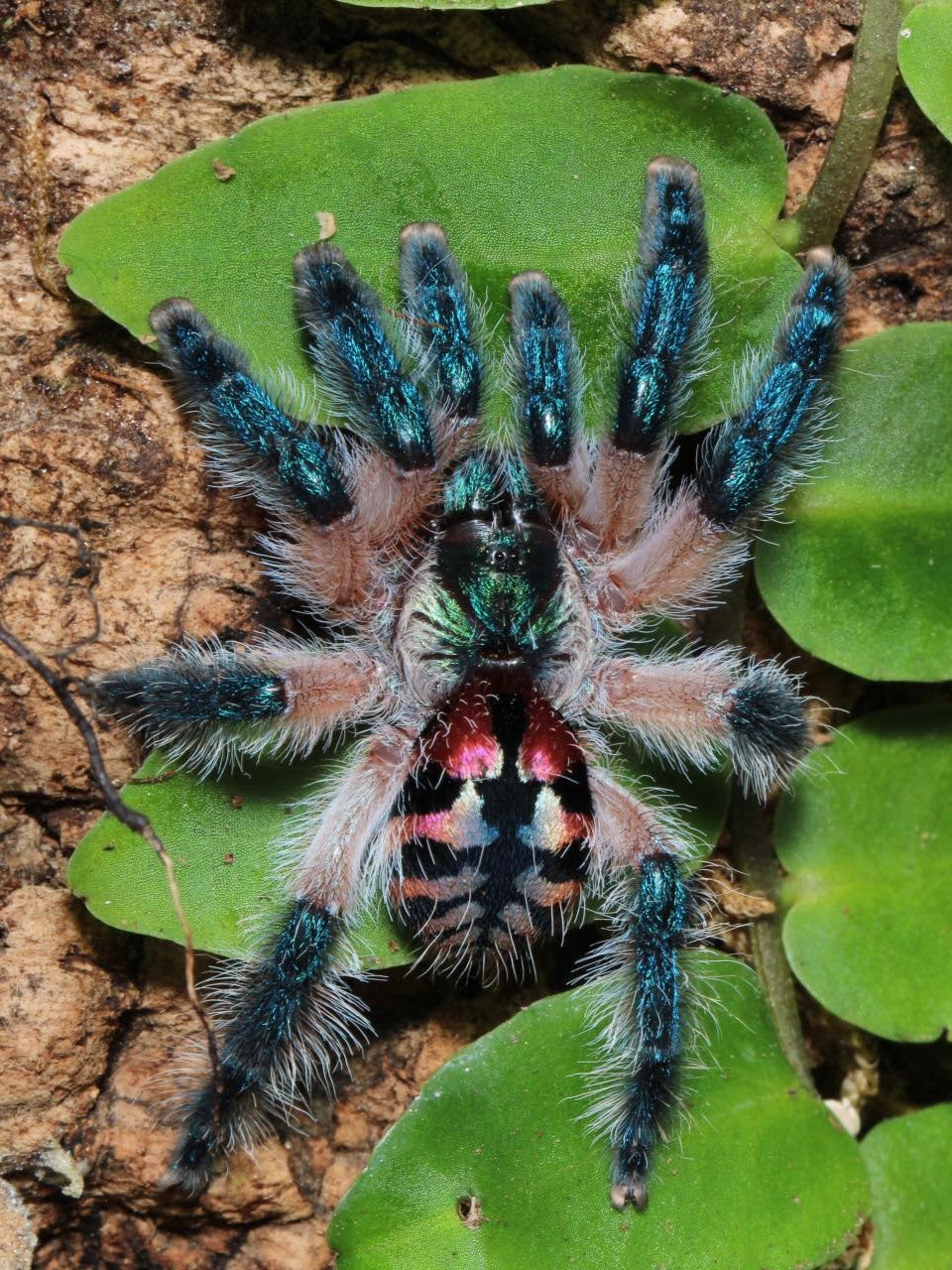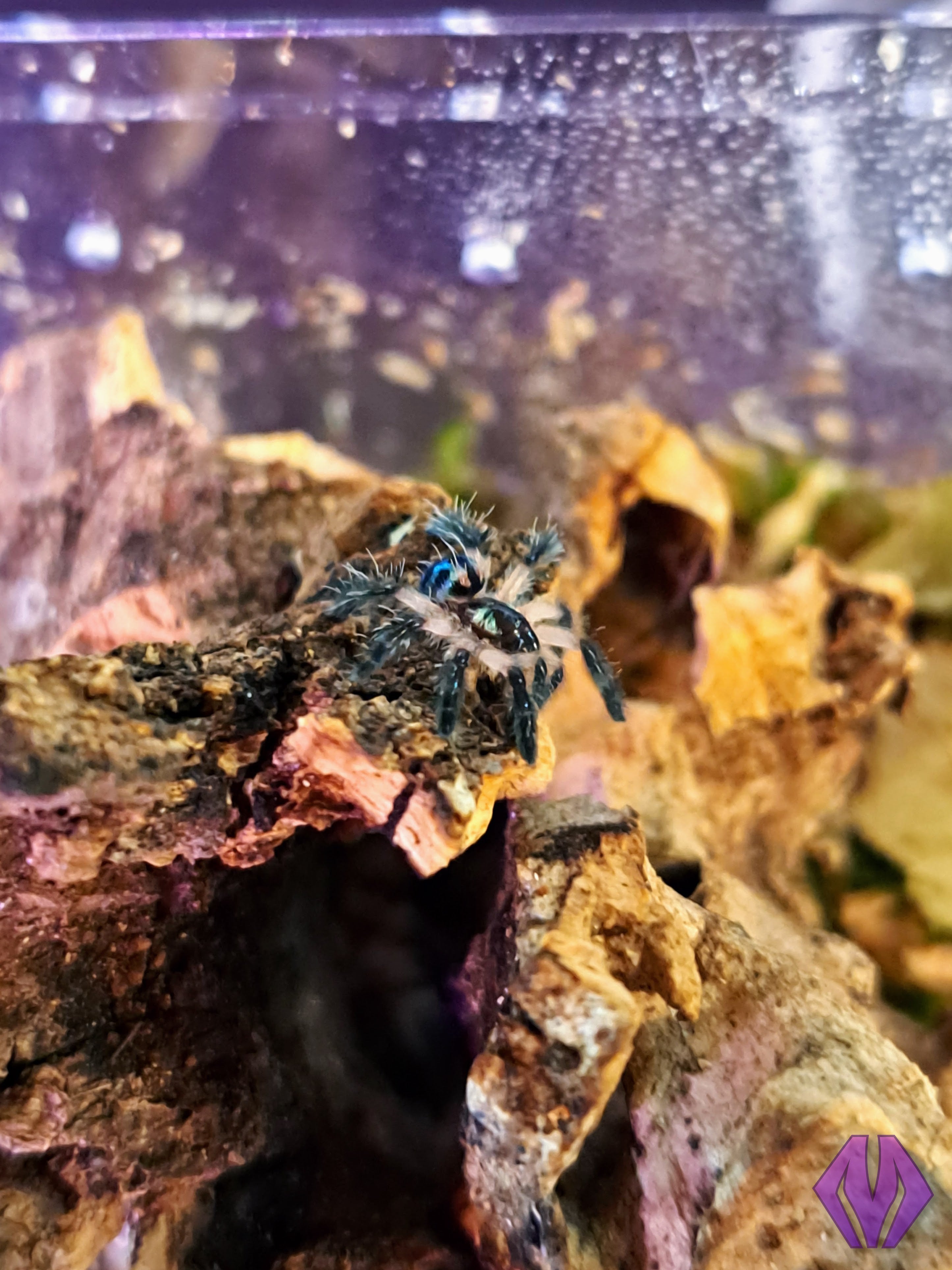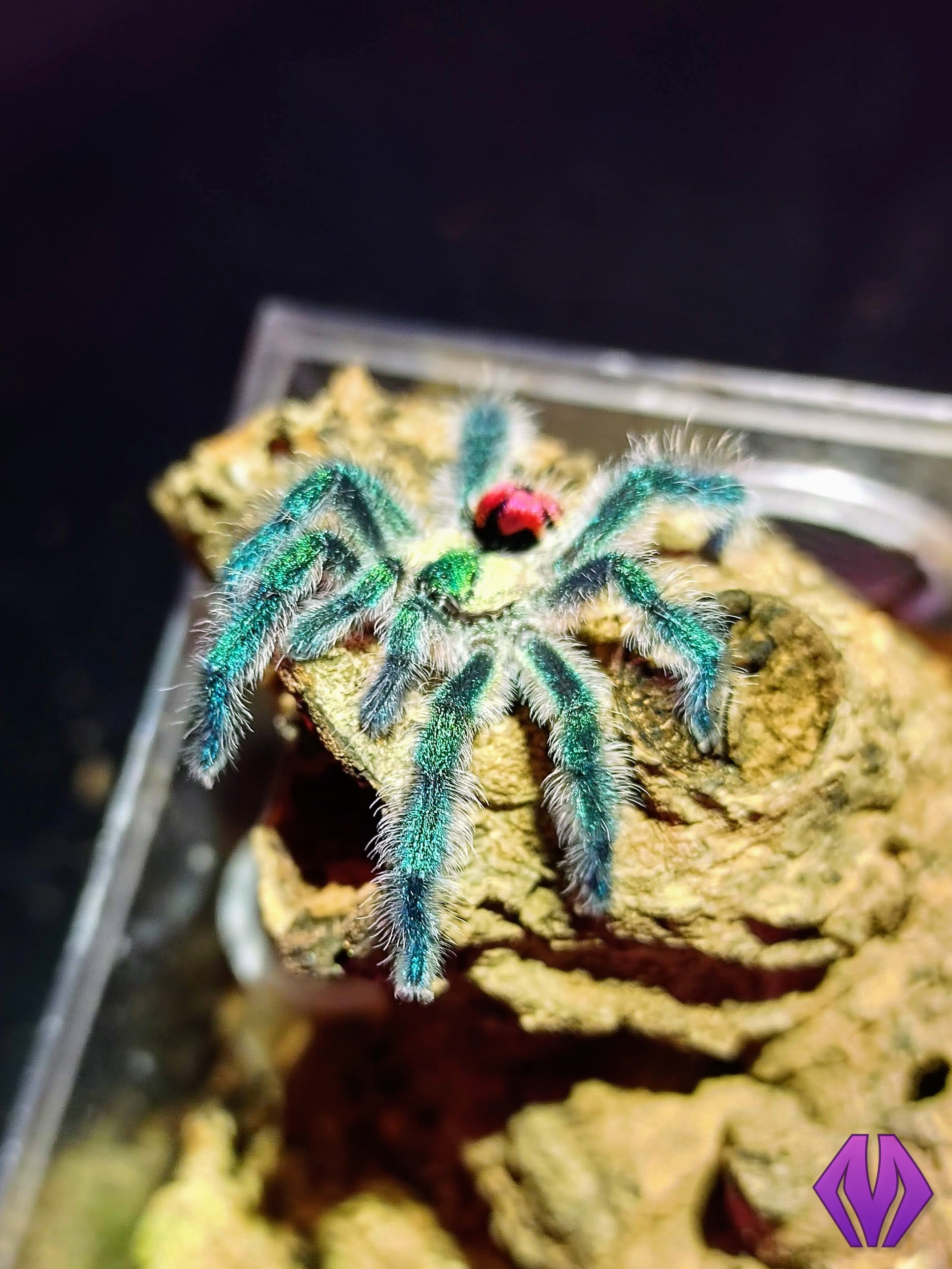Typhochlaena seladonia care guide
description
the Brazilian jewel tarantula (Typhochlaena seladonia) is arguably one of the most colorful and strikingly beautiful species known in the hobby. First described in 2012, we are still learning more about the natural history and captive husbandry for this arboreal, dwarf, trapdoor-building species. Husbandry and hardiness for this species is debated as well, but we have found them to be not much different than any other Aviculariinae or pinktoe species.
-

adult female (photo used with permission from Hunter Straup)
-

second instar spiderling
-

mature male
natural history
courtesy of Logan Hope (@thatbeardedbugguy on instagram)
Originally discovered and described in 1841 by German entomologist Karl Ludwig Koch, it wasn’t until 1851 that it was placed in the genus Typhochlaena. It bounced around genera over the next 150+ years but was ultimately placed back in Typhochlaena in 2012 when four more species of the genus were discovered and described.
Like the common name suggests, T. seledonia are native to Brazil, inhabiting a particular habitat known as Mata Atlantica, or the Atlantic Rainforest – a stretch of old growth forest along the Brazilian east coast. Originally stretching for over one million square kilometers along the coast, due to habitat destruction over the last century there is less than 5% of this unique ecosystem remaining. In the states of Bahia and Sergipe where T. seledonia can still be found, you have to head into the Atlantic lowland forest where the old growth trees still remain. In this region, temperatures range anywhere from 68F to 90F, but averages around 78F year-round, with a humidity of around 80%.
In these old forests, it’s tricky to find T. seledonia. These spiders use their unique arboreal trapdoors to create a concealed hide in a depression or hole found on a tree trunk, either at the bottom of a tree, or near the canopy. Researchers have found that distribution of T. seledonia is directly proportional to the success and distribution of one tree species in particular, Curatella americana, or the Wild Cashew Tree.
enclosure design
T. seladonia is considered a dwarf species with females reaching about 1.5-2.5" diagonal legspan, and males slightly smaller. We keep adult females in Exo Terra nano tall 8x8x12" glass enclosures, which we prefer due to their built-in cross-ventilation feature, front-opening doors, locking mechanism, and clean look. The lid might pose an issue with tarantula claws getting stuck in the mesh, so consider replacing it with a sheet of ventilated acrylic or a pre-made replacemend lid. T. seladonia are obligate trapdoor-builders, so extra care must be taken to select natural enclosure decor that is porous, has a lot of surface area, and/or can be drilled to create more crevices for trap site selection. Cork bark has served us and our seladonia well in the past - other keepers have drilled holes in their cork bark with success. Of equal importance to trap sites is a varied and particulate "trap mix" that should make up the top layer of substrate. We blend up leaf litter, sphagnum and pillow moss, lichen, and bits of bark for our trap mix. For substrate under the trap mix, we use the same megamix tropical substrate that we use for all other tropical species. Spiderlings start out at about 1/4-1/3" and are housed in 40 dram vials or acrylic enclosures measuring about 2x2x4". Juveniles (starting at about 4th-5th instar) are moved to AMAC 4x4x7s.
Proper husbandry of this species absolutely requires ample ventilation to prevent stagnant conditions, which can be improved with forced airflow. We have two small fans in our large spider room on the low setting running 24/7. If you choose to use a fan, be sure to place it so it is not blowing directly at your enclosure(s). The Stack Effect or the Chimney Effect can also be utilized on a small scale to make a big difference.
maintenance
At Marshall Arachnids, we strive to take each species’ natural history into account when designing and maintaining vivaria for our spiders. We provide our T. seladonia adults and slings with a thermal gradient of about 78 to 84°F, with the top of the enclosure being the warmest. Although T. seladonia are relatively inactive and don't thermoregulate the same way other arboreal species do, this heat gradient may still be taken into consideration by the spider when it is choosing a new trap site or modifying its current trap. We use a fine mister to spritz lightly about every other day to provide fresh water droplets to drink from and to raise ambient humidity for live plants. Once a week or so, we will also use a squeeze bottle to dribble a few drops of water directly onto the trap door so the spider can drink directly from it if needed. We add a small amount water to the substrate for live plants and clean-up crew as needed, but we are careful to not saturate the substrate. Change the water dish a few times a week, or as soon as it is soiled.
For adults, we release a few appropriately sized prey items (about 3-4 1/2" crickets) into the enclosure for the spiders to hunt as they please. You may also try tong feeding and placing the prey right at the mouth of the trap, but ours typically don't eat this way so don't be discouraged if yours are the same. For slings, we offer food approximately every 5-7 days or as-needed - 2i and 3i slings will eagerly hunt D. hydei fruit flies or pinhead to 1/8" crickets. This species may occasionally scavenge prekilled prey items, but we haven't tried this method with ours. You'll know if your seladonia does not want to be disturbed due to an impending molt by the sealing of their trapdoor with extra webbing; during this time, we are hands-off and do not offer food until the spider emerges post-molt. These spiders can safely go weeks on end without food, so do not be concerned if this is the case. Just continue to mist and provide clean water regularly. Remove any uneaten prey items the following day after feeding.
We encourage keepers to avoid being mechanical about the care of their seladonia (and all tarantulas for that matter). Note the relative abdomen size, molt rate, etc when deciding whether to offer prey. Note the moisture level in the enclosure (is there condensation building up on the sides? Does the substrate appear damp? These may be signs that you are misting too heavily, or need to increase air flow/ventilation) and adjust your routine accordingly. Don't chase after specific humidity numbers, but do use them to inform how often to mist, because lower ambient humidity may lead to faster dehydration rates and vice versa. And lastly, when in doubt, avoid changing anything or disturbing the spider and reach out to us with questions!
Extra notes on behavior
- It is perfectly normal for the keeper to almost never see their seladonia - after all, that's why they build their own shelter in the form of a trapdoor. We've never experienced or seen other keepers report a seladonia passing away inside the trap. Usually the spider will come out to seek water or something else if it is ill or dehydrated, so we recommend very rarely if ever disturbing the spider while it is in its trap other than to occasionally check abdomen size.
- T. seladonia will molt within their trap and usually toss their old molt right out below the trap. Sometimes they will come out and throw their molt into their water dish! There is no reason for the keeper to attempt to remove the molt prior to the spider discarding it from the trap.
- In very rare (but still normal) instances, seladonia may molt outside of a trap. Do not panic if this happens - but do consider that the spider may be seeking more appropriate trap sites and/or trap-building material.
- T. seladonia may choose to abandon their old trap after molting in favor of finding a better, larger spot to build a new trap. This may be a good time to consider an upgrade in housing size or new trap sites. It's also wise to rehouse while the spider is still inside the trap by removing the entire piece of wood/material that the trap is on and placing that in the new enclosure with more potential trap site choices.
- It can take weeks for a recently rehoused seladonia to find an appropriate trap site and gather enough trap material to create the door. If your seladonia seems restless and hasn't made a trap for a little while, resist the urge to add or change anything, as this typically just causes more stress. Continue to keep the spider warm and hydrated during this time. If your spider goes more than a few months without building a trap and is not eating, then you may want to reevaluate your husbandry and provide more trap site options. On rare occasions, we have had one or two slings/juveniles go months without making a trap, but they were still healthy and eating/drinking.
- Some T. seladonia may still eat while they are out of their trap or haven't yet built a trap, so you may consider offering a prey item during this time. Remove any uneaten food the next day.
- In our opinion and experience, T. seladonia is not a handleable or hands-on species and does not enjoy being disturbed by human contact. Resist the urge to interfere with their natural behaviors as often as possible and your spider will thrive.
Fun Fact! There are only a small handful of tarantula species that are trapdoor builders. Others in the Typhochlaena genus (T. curumim, T. costae, T. amma for example) and Idiothele mira are a few of these unique Theraphosids.



